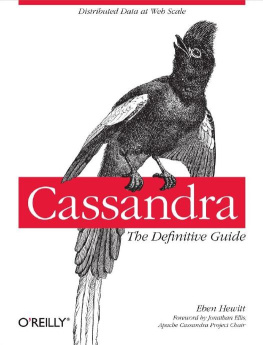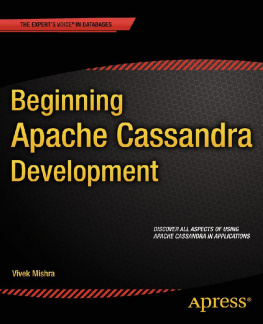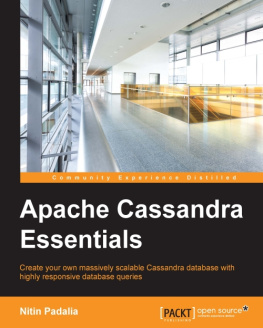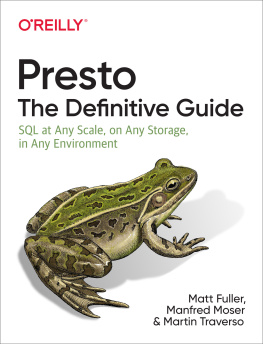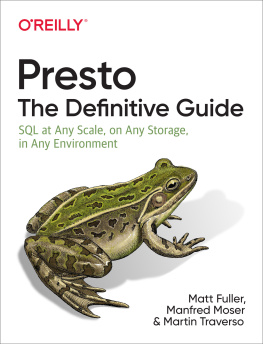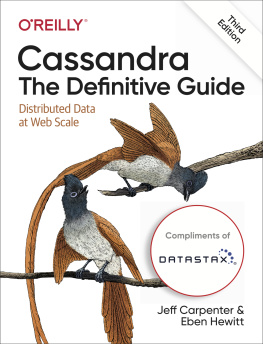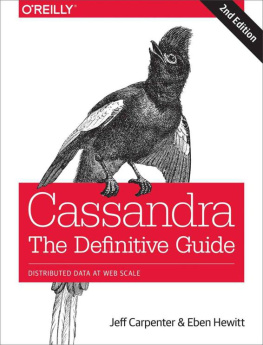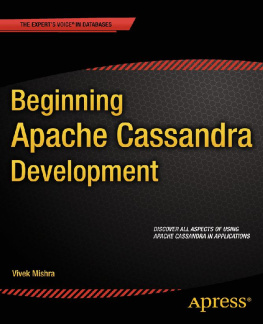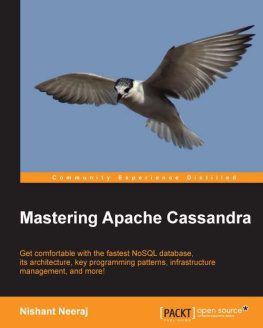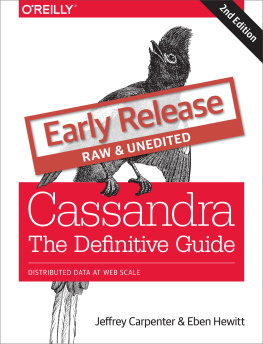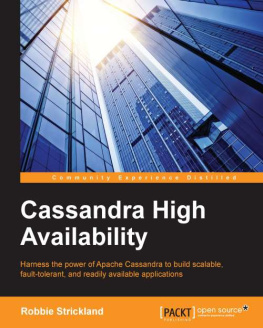Hewitt - Cassandra: The Definitive Guide
Here you can read online Hewitt - Cassandra: The Definitive Guide full text of the book (entire story) in english for free. Download pdf and epub, get meaning, cover and reviews about this ebook. year: 2010, publisher: OReilly Media, Inc., genre: Computer. Description of the work, (preface) as well as reviews are available. Best literature library LitArk.com created for fans of good reading and offers a wide selection of genres:
Romance novel
Science fiction
Adventure
Detective
Science
History
Home and family
Prose
Art
Politics
Computer
Non-fiction
Religion
Business
Children
Humor
Choose a favorite category and find really read worthwhile books. Enjoy immersion in the world of imagination, feel the emotions of the characters or learn something new for yourself, make an fascinating discovery.
Cassandra: The Definitive Guide: summary, description and annotation
We offer to read an annotation, description, summary or preface (depends on what the author of the book "Cassandra: The Definitive Guide" wrote himself). If you haven't found the necessary information about the book — write in the comments, we will try to find it.
With this hands-on guide, youll learn how Apache Cassandra handles hundreds of terabytes of data while remaining highly available across multiple data centers -- capabilities that have attracted Facebook, Twitter, and other data-intensive companies. Cassandra: The Definitive Guide provides the technical details and practical examples you need to assess this database management system and put it to work in a production environment.
Cassandra: The Definitive Guide — read online for free the complete book (whole text) full work
Below is the text of the book, divided by pages. System saving the place of the last page read, allows you to conveniently read the book "Cassandra: The Definitive Guide" online for free, without having to search again every time where you left off. Put a bookmark, and you can go to the page where you finished reading at any time.
Font size:
Interval:
Bookmark:

 Cassandra: TheDefinitive GuideEben Hewitt
Cassandra: TheDefinitive GuideEben Hewitt Published by OReilly Media Beijing Cambridge Farnham Kln Sebastopol Tokyo This book is dedicated to my sweetheart, Alison Brown. I can hear the sound of violins, long before it begins. SPECIALOFFER: Upgradethis ebook withOReilly for more information on this offer! Please note that upgrade offers are not available fromsample content.A NoteRegardingSupplementalFiles Supplemental files and examples for this book can be found at http://examples.oreilly.com/0636920010852/ Please use a standard desktop web browser to access these files, as they may not be accessible from all ereader devices. All code files or examples referenced in the book will be available online. For physical books that ship with an accompanying disc, whenever possible, weve posted all CD/DVD content. Note that while we provide as much of the media content as we are able via free download, we are sometimes limited by licensing restrictions.
Published by OReilly Media Beijing Cambridge Farnham Kln Sebastopol Tokyo This book is dedicated to my sweetheart, Alison Brown. I can hear the sound of violins, long before it begins. SPECIALOFFER: Upgradethis ebook withOReilly for more information on this offer! Please note that upgrade offers are not available fromsample content.A NoteRegardingSupplementalFiles Supplemental files and examples for this book can be found at http://examples.oreilly.com/0636920010852/ Please use a standard desktop web browser to access these files, as they may not be accessible from all ereader devices. All code files or examples referenced in the book will be available online. For physical books that ship with an accompanying disc, whenever possible, weve posted all CD/DVD content. Note that while we provide as much of the media content as we are able via free download, we are sometimes limited by licensing restrictions.
Please direct any questions or concerns to . ForewordJonathan Ellis Project Chair, Apache Cassandra, and Cofounder, Riptano Cassandra was open-sourced by Facebook in July 2008. This original version of Cassandra was written primarily by an ex-employee from Amazon and one from Microsoft. It was strongly influenced by Dynamo, Amazons pioneering distributed key/value database. Cassandra implements a Dynamo-style replication model with no single point of failure, but adds a more powerful column family data model. I became involved in December of that year, when Rackspace asked me to build them a scalable database.
This was good timing, because all of todays important open source scalable databases were available for evaluation. Despite initially having only a single major use case, Cassandras underlying architecture was the strongest, and I directed my efforts toward improving the code and building a community. Cassandra was accepted into the Apache Incubator, and by the time it graduated in March 2010, it had become a true open source success story, with committers from Rackspace, Digg, Twitter, and other companies that wouldnt have written their own database from scratch, but together built something important. Todays Cassandra is much more than the early system that powered (and still powers) Facebooks inbox search; it has become the hands down winner for transaction processing performance, to quote Tony Bain, with a deserved reputation for reliability and performance at scale. As Cassandra matured and began attracting more mainstream users, it became clear that there was a need for commercial support; thus, Matt Pfeil and I cofounded Riptano in April 2010. Helping drive Cassandra adoption has been very rewarding, especially seeing the uses that dont get discussed in public.
Another need has been a book like this one. Like many open source projects, Cassandras documentation has historically been weak. And even when the documentation ultimately improves, a book-length treatment like this will remain useful. Thanks to Eben for tackling the difficult task of distilling the art and science of developing against and deploying Cassandra. You, the reader, have the opportunity to learn these new concepts in an organized fashion. PrefaceWhy ApacheCassandra? Apache Cassandra is a free, open source, distributed data storage system that differs sharply from relational database management systems.
Cassandra first started as an incubation project at Apache in January of 2009. Shortly thereafter, the committers, led by Apache Cassandra Project Chair Jonathan Ellis, released version 0.3 of Cassandra, and have steadily made minor releases since that time. Though as of this writing it has not yet reached a 1.0 release, Cassandra is being used in production by some of the biggest properties on the Web, including Facebook, Twitter, Cisco, Rackspace, Digg, Cloudkick, Reddit, and more. Cassandra has become so popular because of its outstanding technical features. It is durable, seamlessly scalable, and tuneably consistent. It performs blazingly fast writes, can store hundreds of terabytes of data, and is decentralized and symmetrical so theres no single point of failure.
It is highly available and offers a schema free data model. Is This Book forIs This Book forYou? This book is intended for a variety of audiences. It should be useful to you if you are: A developer working with large scale, high-volume websites, such as Web 2.0 social applications An application architect or data architect who needs to understand the available options for high performance, decentralized, elastic data stores A database administrator or database developer currently working with standard relational database systems who needs to understand how to implement a fault-tolerant, eventually consistent data store A manager who wants to understand the advantages (and disadvantages) of Cassandra and related columnar databases to help make decisions about technology strategy A student, analyst, or researcher who is designing a project related to Cassandra or other non-relational data store options This book is a technical guide. In many ways, Cassandra represents a new way of thinking about data. Many developers who gained their professional chops in the last 1520 years have become well-versed in thinking about data in purely relational or object-oriented terms. Cassandras data model is very different and can be difficult to wrap your mind around at first, especially for those of us with entrenched ideas about what a database is (and should be).
Using Cassandra does not mean that you have to be a Java developer. However, Cassandra is written in Java, so if youre going to dive into the source code, a solid understanding of Java is crucial. Although its not strictly necessary to know Java, it can help you to better understand exceptions, how to build the source code, and how to use some of the popular clients. Many of the examples in this book are in Java. But because of the interface used to access Cassandra, you can use Cassandra from a wide variety of languages, including C#, Scala, Python, and Ruby. Finally, it is assumed that you have a good understanding of how the Web works, can use an integrated development environment (IDE), and are somewhat familiar with the typical concerns of data-driven applications.
You might be a well-seasoned developer or administrator but still, on occasion, encounter tools used in the Cassandra world that youre not familiar with. For example, Apache Ivy is used to build Cassandra, and a popular client (Hector) is available via Git. In cases where I speculate that youll need to do a little setup of your own in order to work with the examples, I try to support that. Whats in ThisBook? This book is designed with the chapters acting, to a reasonable extent, as standalone guides. This is important for a book on Cassandra, which has a variety of audiences and is changing rapidly. To borrow from the software world, I wanted the book to be modularsort of.
If youre new to Cassandra, it makes sense to read the book in order; if youve passed the introductory stages, you will still find value in later chapters, which you can read as standalone guides. Here is how the book is organized: This chapter introduces Cassandra and discusses whats exciting and different about it, who is using it, and what its advantages are. This chapter walks you through installing Cassandra on a variety of platforms. Here we look at Cassandras data model to understand what columns, super columns, and rows are. Special care is taken to bridge the gap between the relational database world and Cassandras world. This chapter presents a complete working application that translates from a relational model in a well understood domain to Cassandras data model.
Next pageFont size:
Interval:
Bookmark:
Similar books «Cassandra: The Definitive Guide»
Look at similar books to Cassandra: The Definitive Guide. We have selected literature similar in name and meaning in the hope of providing readers with more options to find new, interesting, not yet read works.
Discussion, reviews of the book Cassandra: The Definitive Guide and just readers' own opinions. Leave your comments, write what you think about the work, its meaning or the main characters. Specify what exactly you liked and what you didn't like, and why you think so.

